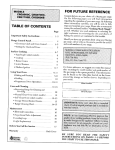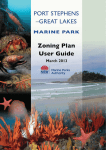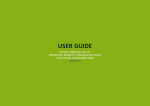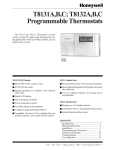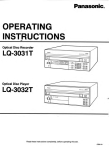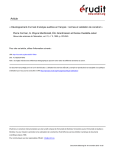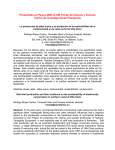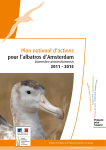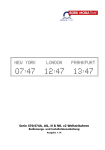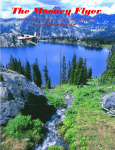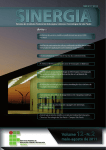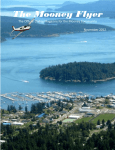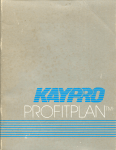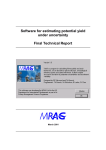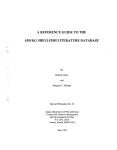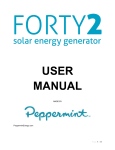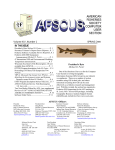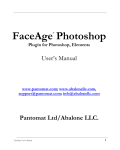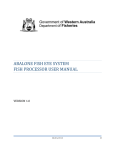Download Extension of abalone fishery research to industry and others by way
Transcript
EXTENSION OF ABALONE FISHERY RESEARCH
TO INDUSTRY AND OTHERS BY USING INTERACTIVE
EDUCATIONAL COMPUTER SOFTWARE
(FIRDC Project 89/8)
FINAL REPORT
to
FISHERIES RESEARCH AND DEVELOPMENT CORPORATION
by
SOU'fil AUS'l'R.ALIAN DEPARTMENT OF FISHERIES
1$ December 1991
FINAL REPORT - FIRDC Project 89/8
SECTION 1
-
PROJECT TITLE
EXTENSION OF ABALONE FISHERY RESEARCH TO INDUSTRY AND
OTHERS BY USING INTERACTIVE EDUCATIONAL COMPUTER
SOFTWARE
SECTION 2
-
OBJECTIVES
The objectives of the originally proposed project were:
To make recent advances in abalone research accessible to the
Australian abalone industry;
To improve management of abalone fisheries through increased
knowledge and understanding
To develop new techniques of applying the results of fisheries research.
FIRDC granted only a small proportion of the funds originally applied for.
A year later, after viewing a prototype, it granted supplementary funding:
To complete the software that now exists in prototype form;
To edit and produce a user manual from the existing draft;
To design an educational computer based training package;
To present the model at the lst World Fisheries Congress.
A proposed "workshop tour to transfer the results to industry" was not funded.
SECTION 3 - RESULTS
3.1
General
The project has resulted in the production and distribution of the AbaSim
software package, two copies of which accompany this report.
Appendix A, copied from the user manual, lists acknowledgements, shows the
contents of the manual and describes how to use the package. The benefits
offered by the software package are listed on the order form (Appendix B).
Additionally, a prototype of an educational computer based training package
called AbManager has been produced in collaboration with Dr Rob Day of
Melbourne University, who will trial it in 1992.
1
The World Fisheries Congress was postponed for a year due to the Gulf War.
However AbaSim has been widely shown to North American and European
fisheries scientists (see below).
3.2
Distribution
The AbaSim package was released in September 1991.
Following consultation with the South Australian Abalone Divers Association, it
was decided that an effective way of distributing the package to the Australian
abalone industry was to deliver six copies of the package to the abalone
industry associations in various states. This has been achieved via state
fisheries departments, each of which was requested to maintain one copy in
their library.
Additional copies have been distributed to other Australian fisheries
departments and training institutions. These organisations were encouraged to
obtain additional copies for use in staff training and to assist in further
distribution.
In August 1991, FIRDC agreed that the South Australian Department of
Fisheries sell AbaSim commercially. FIRDC will receive 10% of the sale price.
The decision will be reviewed after three years.
As part of an overseas trip in September 1991, the project leader, Dr Philip
Sluczanowski, demonstrated AbaSim at the annual conferences of the
American Fisheries Society, the UK Marine Conservation Society and ICES.
He also showed it to key officers at FAO (Rome), UNESCO (Paris) and RRAG
(London). A number of sales have resulted and discussions are being held with
potential overseas agents and distributors.
AbaSim was purchased and used as part of an FAO training project in Fiji in
November 1991.
3.3
Feedback
The response of everyone who has seen or used the package confirms that it
meets the original objectives of the project.
Commercial and recreational fishers, conservationists, fisheries managers,
science communicators, research managers and senior scientists have been
particularly enthusiastic about the benefits of the technology for providing new
insights into the behaviour of fisheries systems that must be managed based on
limited information (see Appendix C). Beverton, Pope, Shepherd, Holden,
Megrey, Edwards, Garcia, Troost and Griffith praised the model.
They see the main uses of such models as communicating key and difficult
fisheries management concepts to non-specialists (e.g. sustainable development,
growth and recruitment overfishing, time higs, age sampling, cycles,
rehabilitation). A user has remarked that "It's a great little minister convincer "
2
Some scientists suggest· that AbaSim is not as useful as it could be because :
the user cannot change the model parameters and thereby examine
sensitivity;
(AbaSim was not intended to be a scientific tool.)
the assumptions of the model are not clearly stated in the
documentation;
(The documentation was aimed at non-specialists. "Small print" and
references are provided for those who seek them.)
AbaSim gives the false impression that fisheries management is simpler
than it is in reality. In particular , the model does not take account of
random variation or environmental effects and it is difficult to
communicate uncertainty.
(The scope of the product had to be limited and a complicated model
would have alienated many potential users. The ideal presenters of
AbaSim are scientists who use it to communicate general principles and
then qualify the model in relation to the real world.)
3.4
Future development
A list of possible improvements to the package has been compiled and is
continually being updated in response to user feedback. The information would
be incorporated into the specification of a future product, if feasible and
justified.
·During 1992, the SA Department of Fisheries will market AbaSim, seeking the
best mixture of means of distribution (e.g. mail order, agents, distributors,
publishers). The marketing project will be reviewed at the end of 1992 and
decisions made regarding further distribution, future product development and
the feasibility of the department commercialising such products.
A supplementary grant may be sought to support the trialing, refinement of the
prototype and specification of the AbManager package.
APPENDICES
A
Acknowledgements, Contents of manual, Use of package
Copied from the AbaSim user manual.
B
AbaSim order form
C
''Flying Fisheries"
Article for American Fisheries Society Computer Users Section newsletter.
3
�
ConLrrlt.s
�
�
Warning
Unauthorised copying of
The project was funded by
South Australian Department of Fisheries
the AbaSim software or manual
Fishing Industry Research and Development
is unethical and illegal
Trust Fund
Published by the South Australian
The authors
Department of Fisheries
GPO Box 1625, SA, Australia 5001
First published 1991
© Copyright South Australian Department of
Fisheries 1991
AbaSim: A Graphic Fishery
ISBN 0 7308 1899 3
Tasmanian Fisheries Development
Authority: research
Tasmanian Abalone Divers Research &
Development Trust Account: research
Fishing Industry Research Trust Account:
research
Contents
Start here
About this manual , AbaSim and models
2
1 Abalone biology
4
2 Abalone divers
8
3 Fisheries management
3.1 Stock indicators
3.2 Fisheries management tools
3.3 Managing a fishery
10
10
11
12
Software patent applied for.
All rights reserved.
4 Games
14
Acknowledgments
Game 1 - Gradual development of a fishery 15
John Tonkin, a computer artist, programmed
Game 3 - Pulse fishing
the computer game.
We thank for their assistance, support and
inspiration:
Abalone divers, their families and
representatives
Garis Alexander, Alan Annstrong, Janine
Baker, Kevin Branden, Tracy Brothers, Barry
Burr, Merle Cammiss, Steven Clarke, Rob
Day, Lesley Fairbaim, Luclmilla Filadelfi,
Shaun Forbes, Wesley Ford, Ray Hilborn,
Patrick Hone, John Jefferson, John Johnson,
!an Kirkegaard, Neil Klaer, Gordon
Kuckhahn, Rob Lewis, Vivienne Mawson,
Carol Moore, John Nowland, Mick O lsen ,
Sharon Palmer, Russ Reichelt, Natalie
Schenk, Scoresby Shepherd, Hosi Stankovic,
Simon Talbot, Richard Tilzey, Angelo Tsolos,
Mike Walker, Carl Waiters, Meryl Williams,
Gavin Wright, Marko Zagar
Game 2 - Bonanza
5 Lessons
19
21
23
5.1 Abundance and catch rates
5.2 Time lags
5.3 Size (Age) limits
23
5.4 Quotas
26
5.5 Research surveys
26
24
25
6 O per ati o n
6.1 Computer hardware required
6.2 I nstalling the program
27
27
6.3 Starting and stopping the program
27
6.4 The main screen
28
6.5 Keyboard control
6.6 Saving and loading scenarios (games)
29
30
Appendices
A Ordering the software, service
B Details of the models
32
C Further reading
34
31
© 1991 SADF
c n
(f) 0
(1) :J
rt
0 (1)
H) :J
rt
"() (f)
OJ
0 0
" H)
OJ
lQ
::;::
(1) OJ
:J
c
OJ
f-'
»"
0
"
:J
0
�
f-'
(1)
Q,
lQ
(1)
3
(1)
:J
rt
(f)
""
"()
"()
tTJ
z
0
H
><
""
'-._./
"'-.../
Start lH�rt·'
Start here
�
Start here
"-..../
�
computer. Instead, free your imagination; you are a god playing Vvith the world1
Well, not quite, but you are the manager of a fishery. And your computer is a
About this manual
Usually when people buy a new computer game, they cannot wait to try it.
But before you use AbaSim, please Resist this temptation/
terminal which reports what is happening in the world.
When using AbaSim, keep asking the question: "What happens if.
. ?"
and use
the model to find out. Before making the model simulate a situation, try to
Read the first three chapters of this manual first, and then play the games
predict what will happen and why. The gap between your expectation and
described in chapter 4. You will learn about abalone and fisheries management,
what happens will stimulate you to think further and generate greater
and be entertained on the way.
understanding and insigh t.
The AbaSim program and manual were designed for a wide audience. We do
Good fisheries biologists learn about a fishery by applying scientific research
not assume you know anything about abalone or about personal computers
techni ques, studying the results and ta lking and working Vvith fishers and other
(PC's). But you will need to have access to a computer compatible with.an
mM-PC 286 Vvith a colour VGA
screen, preferably with a maths coprocessor.
AbaSim simulates what happens to a population of blacklip abalone,
Haliotis rubra, on a reef when it is fished by abalone divers. The model uses
information about the growth, reproduction, mortality and movement patterns
of abalone and the behaviour of divers. It represents scientists' understanding
observers of the stocks. They then build a picture, or mental model, of how the
fishery works. Most fishers do the same. Both use these mental models to help
them understand and pre dict what Vvill happen in the fishery the fishers to
he lp them cat c h fish e ffectively, and the biologists to manage the fishery
better. A model is a purposeful representation of reality
When you stop using the simulator, remind yourself that the AbaSim model is
of the dynamics of a fishery based on the abalone that live on a small reef off
just a model and not an exact duplicate of the real world It represents some of
Tasmania. The fishery based on this stock was studied as part of a major
what we currently believe about abalone fisheries; it is not an actual abalo ne
research program carried out in Australia between 1984 and 1987, led by
stock. It is limited by the extent and accuracy of research to date, our overall
Dr Jeremy Prince.
Chapters 1 , 2 and 3 introduce you to abalone biology, abalone divers and
fisheries management. If you want more details about the models and their
relationship to research results, consult "the small print" in Appendix B, the
references (Appendix C) or write to the authors. Scientists are still
investigating many of the issues discussed.
Chapter 4 (Games) is the most important in the manual. Use it to discover the
dynamics of AbaSim Reef while "playing". Use this chapter to learn how to use
the simulator. Don't cheat, or you'll miss some surprises. Chapter 5 discusses
useful lessons about fisheries that arise from Chapter 4.
understanding and what is fea si b le w
mod e l
Models
s uc h as
AbaSim
are
useful for developing un d erstan di ng , but not neces s a ril y for making accurate
pre dictions about the real world. The purpose of this model is to gain msights
and to find out where our unders tan d ing about the real world is weak and
should be improved.
The successful management of fi sheries is vi tal not o n l y to the people whose
livelihoo d depends on them, but also to a world of d vvi ndling natural resources.
Fisheries managers are at the forefront of learning how living r e s our c e s can be
developed in a sustainable way. AbaSim is designed to help managers under
stand how fisheries behave- and how mana gers ' actions can affect them.
Enjoy using AbaSim. Please don't spoil the game for others by shovving them
Chapter 6 tells you how to install the software and operate the program. It
what they should discover for t he m sel v e s Your suggestions for improvements
explains how information is shown on the computer screen. Use this chapter
are welc ome .
for reference.
Philip Slucz anowsk i, Producer
When you use AbaSim, try to forget you are sitting in an office Vvith a
30 August 1991
2
3
<rJ !991 SADf
© 19Bl SADF
< JVt!f""'llti
APPENDIX
AbaSim
B
Order
Form
AbaSim
"Faaaaantastic.
'he games are very
easy to 'play',
:tructions are easy
J
The AbaSim computer program
The
�reen is brilliant."
Carol Moore
based on a shellfish population that lives on
Try be ing its manager. Your aim is to preserve the fish stock and develop it sustainably.
While "playing" the easy-to-use computer program, you will learn important principles of fisheries
management, and be entertained at the same time.
AbaSim simulates what happens to a p o p ulati on of abalone when it is fished by abalone
Senior Co m puter
Systems Officer
si mulates a fi shery
AbaSim Reef.
learn and apply,
get used to.
FISH INSIGHT
A GRAPHIC FISHERY: Learning tool for fisheries management
'ions few and easy
J
on1cr I<JfHl
divers. Each year, y ou
can
change the minimum size li mi t and adjust the fishing pressure. The
catch and profitability of abalone divers harvesting the reef respond to your controls. Y o u
immediately see the effects as coloured dynamic graphics e asi l y understood by non-specialists. You
is program
ser
comes
than anything
can also
,
The
revealing how
behave.
exciting."
oresby Shepherd,
Biologist
AbaSim program and manual were designed for
a wide audience. To use it, you do not
need computer experience or knowledge about fisheries or abalone.
It is
-evolutionary and
about growth, reproduction,
m ortality movement patterns and diver behaviour. It is based on real data.
�lse I have seen to
alone populations
carry out reaearch surveys. The model uses informat ion
The manual tells you about abalone biology, fisheries management, and the Australian fish ery
on which the model is based.
An "easy-going" commentary leads you through sc enari os
,
relates
them to real world experiences, andleaves you to manage the fishery on your own. Later, it
explains what happened and why, and drawslessons relevant to the real world.
The Australian Fishing Industry Research and Development Trust Fund CFIRDTF) supported the
development of AbaSim. and benefits from its distribution.
AbaSim should be co nsidered a cost-effective and time saving method of improving the
performance
ffElUES MANAGERS
•
and underStanding of participants in the fisheries management process.
The successful management of fisheries is vital not o nl y to the people whose livelihood depends
on them, but also to a world
of dwindling natural resources. Fisheries managers are at the forefront
oflearning how living resources
can be developed in a sustainable way. AbaSim is designed to help
managers understand how fisheries behave - and how managers' actions can affect them.
�ISHING INDUSTRY
•
Continued and profitable harvesting of natural resources requires an understanding of the
dynamics of the fish stock, a commercial fishery's core asset. This requires knowledge of biology and
of population dynamics. AbaSim teaches these subjects simply.
ONSERVATIONISTS
•
It is important that the public appreciates what is meant by sustainable management. Then
they can respond when non-sustainable practices occur.
AbaSim
can convey an understanding of the basic issues to
a
wi d e audience. The user
can
demonstrate alternative sustainable fishing policies and compare their benefits.
FISHERIES
DEPARTMENTS
•
Staff of a fisheries department appreciate the relevance of their work better if they understand
the basics of fisheries management. AbaSim. has been trialed
as
a training tool to achieve this
Managers, enforcement officers, administrators, communicators and scientists all found the
experience instructional and satisfying.
A perso n
SCIENCE
COMMUNICATORS
•
training with AbaSim. needs about
2-4 hours alone with
a
computer.
The model illustrates types of behaviour often experienced by species other than abalone.
AbaSim
can be easily used to demonstrate some of these (e.g. sustainable development,
overexploitation, time lags, eradication of a stock's spawning potential, age sampling, cycles,
rehabilitation, etc.).
You can also use AbaSim to illustrate analogies in wildlife and other areas of natural
resources management.
.
AbaSim is an educational tool. The manual describes the latest knowledge nbout abalone
I·:DUCATOIL_<;
AND STUDENTS
biology and fisheries management.
Key references
are
listed.
The model is suitable for university t u torial sessions, during which students can either follow
the book's scenarios or be asked to experiment with the model and thereby g a in insights based on
It has relevance in a wide range of s ubj ect s , e.g. biology, environmental studies
their experiences.
and r e so urc e economics, mathematics, communications design and graphics design.
Schoolteachers can easil y use the model to d e mo nstr ate some fundamental lesson:; about the
10-year olds can easily understand the screens and "play the game" after a
behaviour of fisheries.
fe w minutes' tuition .
ERIES SCIENTISTS
•
AbaSim offers a completely new view of the dynamics of an exploited fish stock. Dynamic
visualisation and interactive graphics techniques reveal what is ha p penin g to the populati on
structure when you manage the stock in different ways.
You use AbaSim li ke a flight simulator, gaining a feeling for the sensitivity of the dynamic:s
and i nsights into th e behaviour of the nonlinear system. The screen displa ys offer new
visualisations of co mplex relationships previously only a ccessible throu gh numbers and equations.
(Unfortunately, you cannot change the underlying model parameters.)
)MPUTER ARTISTS
•
John Tonkin, who designed and programmed the screens, is an a w ar d winning Australian
computer artist. AbaSim is an example of how artists can apply th eir uni q ue communications
certainly learn a
fair bit of lww a
skills.
1.ery can collapse
Computer hardware required:
l lww it can also
wed.
Sometimes
Developed
�ar is aU it takes
;aue the fishery."
Angelo Ts olos
Senior Statistics
·
•
maths coprocessor (optional, increases speed)
I think that as a
teaching aid for
xlucing students
7.e broader range
of {is heries
�nagement issues
the model is
unsurpassed."
)on Mackie, past
orcement Officer
Foc details or a quotation on FISH INSIGHT
Australia Telephone 08) 226
Or, Mr, Ma" ..
TITLE
INITIALS
0633
•
services and
0633
Int ... ) 618) 226
OR CHRISTIAN NAMES
Department
products, please
Facsimile
SURNAME
ORGANISATION
08)
of Fisheries,
write to
us.
Or call
our
226 0664 lnt ... ) 618) 226
0664
POSITION
NAME OF SITE LICENCE (FOR SITE LICENCES ONLY)
ADDRESS
TELEPHONE
FACSIMILE
EMAIL
is HALF-PRICE to educational institutions an d course attendees . Please enquire about special prices fo r Australian abalone divers.
0 Single
,s, I would like to order a copy of AbaSim
o
co m p a tibl e
Contact: FISH INSIGHT, South Australian
GPO Box 1625, Adelaide, SA 5001, Australia
FISH INSIGHT
Customer Hotline:
Customer Hotline in
IBM-PC.286
To order your copy of AbaSim, please complete and send or fax this order form to F1SH INSIGHT
Clerk
m
hr.
colour VGA screen
•
not wish to place an order at this time, however, please add
name and address, as indicated above, to your
•see
list of
1 manual
0 Site licence:
in the sum of
1 program diskette
single user
5
5
US$450
acceptable currencies below)
de payable to FISH INSIGHT
licence:
mailing list
1 enclosing a bank draft
US$ or
user
US$195
licence
program diskettes
manuals
site licence
____
Licences HALF-PRICE to ed uca tional institutions and
�ase charge my credit card m Austraan Dollars only
d currency convertion rate and use the US $/Australian
hange rate at time of mailing)
Australian
0 Visa
nerican Express
$
$
____
_
0 MasterCard
wider's name
course attendees
US$
Postage
t card no.
Expiry date
Single
0 Additional manuals
US$25 each
Total
wider's signature
0
Currency
US$
con-
vertion rate
US$
__
_
__
__
_
Grand total US$
__
[ would pre fer to make my payment
r
as
a bank draft .in
curre ncy (see below for list of acceptable currencies) and
dded
US$3 (currency
conversion
rate),
then converted the
Total at exchange rate at time of mailing.
rtralian. Dollar, Austrian &hilling, Belgium Franc, Danish
ner, Dutch Guilder, French Franc, German Mark, Ho718 Ko718
lar, Irish Pound, Japanese Yen, New Zealand Dollar,
,., _____
_,
n.•
,.
Postage: Airmail.
(For
site licences only)
Disk size 0
see
US$225
5W' 0 31h"
below
US$3,
optional
or other currency
*
_
Add one of the following amounts, d epen ding on
order. 1 book: US$10 I 2 or 3 books: US$20
number of books in y ou r
I 4 to
S i te
user US$97.50 0
7 books: US$30 I 8
to
10 books US$45
Delivery: Allow 21 days. Customs duty: We'll make every effort to
ensure your copies of AbaSim reach you quickly and take every
ot
care to protect you from customs duty.
However, we (.8.l1Il
,_ •
..,...e..,.to.D t.'ht:�t.
vnn
... 1 ..... -1
__ _...._
. .
. .
-·-
.
•
-
§
---- :_."""..t -"
APPENDIX
Article
for
American
Fisheries
C
Society
Computer
Users
Section
Newsletter
FLYING FISHERIES
Pilots and fisheries managers both have to control complex dynamic systems in
fluct uating environments. The better they understand the behaviour of the systems
they are trying to manage (i.e. aeroplane or fishery), the more effective they are.
Scientists and engineers usually lead the development of understanding through
research, experimentation and design.
But is this level of understanding sufficient,
and how best to communicate it?
An aeroplane designer is familiar with the equations and performance levels describing
a plane's behaviour and can explain the likely consequences of using different controls
under various conditions. But can he (she) fly a plane?
Certainly not, based on this
"
th eor eti cal" level of understanding. To fly a plane, a pilot
needs to experim ent with the system to gain a feeling for its dynamics, sensitivity
"
"
and responsiveness. The only way to do this is to interact with it through an effective
user int erfac e. This could be either a flight simulator or the aeroplane itself.
Interactive graphics models of fisheries offer similar advantages
.
You can combine the
equations describing a fishery into a computer program which simulates certain
aspects of a its behaviour. You can then outfit this model with a user interface that
allows the user to easily interact with it and immediately see the consequences of
differ ent management actions.
The user
can
"fly" the system and so learn about it.
FISH INSIGHT, a unit of the South Australian D epart me nt of Fisheries, specialises
i n providing a high quality user interface for models developed by others. The
interactive graphics interface makes the models easily accessib le , provides new
insights into their complex dynamics and allows communication of this understanding
to non-specialists.
AbaSim is one such program. It simulates what happens to a population of abalone
when it is fished by divers. As the user, you act as the manager of the fishery. Each
y ear , you can change the minimum size limit and adjust the fishing pressure. The
catch and profitability of abalone divers harvesting the reef respond to your co ntrols
.
You immediately see the effects on the population as coloured dynamic graphics easily
understood by non-specialists. The model is based on real data and uses information
about growth, reproduction, mortality, movement patterns and diver behaviour.
Although AbaSim is based on an abalone population, it illustrates types of behaviour
experienced by species other than shellfish. For example, it is easy to demonstrate
"sustainable development", "growth overfishing", "recruitment overfishing", "the value
of age sampling", "cyclic behaviour", "rehabilitation of a fish stock", etc.
SharkSim is another interactive graphics model. It is based on Australia's southem
shark fishery.
Commissioned as "an agent for change", it was used by scientists and
managers in public meetings to convince industry and the public of the need for urgent
and significant changes to management of the fishery. It did so by effectivel y
communicating scientists' best understanding of the state of the stock and the likely
consequences of altemative management actions.
Scientific visualisation and interactive games are rapidly growing areas of science
made possible by recent advances in computer technology. They will change the ways
in which we view data and analyse relationships.
Dr. Philip Sluczanowski
FISH INSIGHT
South Australian Department of Fisheries
135 Pirie Street, Adelaide, South Australia.
Postal address:
GPO Box 1625, Adelaide, SA 5001, Australia.
Telephone:
..
. 61)
8) 226 0633
Facsimile: . . 61) 8) 226 0664
.
f·
�!&
FISH INSIGHT
�
Ab..Slm
�
�
The project was funded by
Warning
Unauthorised copying
the
South Australian Department of Fisheries
of
Fishing Industry Research and Development
AbaSim software or marnial
Trust Fund
is unethical and illegal
Published by
the South Australian
Department of Fisheries
The authors
Tasmanian Fisheries Development
1625, SA, Australia GOOl
First published 1991
Authority: research
© Copyright South Australia11 DepartineJ1t of
Development Trust Account: research
GPO Box
Fisheries
1991
research
0 7308 1899 3
Software patent applied for.
All rights reserved.
Acknowledgments
John Tonkin, a computer arti8t,
the computer game.
We thank for
inspiration:
prugr:mnncd
their assistance, support and
Abalone divers, thei.Lfamilies
and
representatives
Armstron g, .Janine
Barry
Burr, Merle Ca.nuniss, S teven Clarke, Rob
Garis Alexander, .Alan
Baker, Kevin Branden, Tracy Brothers,
Day, Lesle y Fairbairn, Ludmilla Filadclfi,
Hilborn,
John Jefferson, John Johnson,
Ian Kirkegaard, Neil Klaer, Gordon
Shaun Forbes, Wesley Ford, Hay
Patrick Hone,
Kuckhahn, Rob Lewi s, Vivienne Mawson,
Carol Moore,
John Nowland, Mick Olsen,
Sharon Palmer, Russ Reichelt, Natalie
Schenk, Scoresby Shepherd, Hosi Stankovic,
Simon Talbot, Richard Tilzey, Angelo Tsolos,
Mike Walker, Carl Walters, Meryl Williams,
Gavin Wright, Marko Zagar
&
Fishing Industry Research Trust Account:
AbaSim: A Graphic Fishery
ISBN
Tasmanian Abalone Divers Research
�
AbaSim
�
Start here
�
computer. Instead, free your imagination; you are a god playing with the world!
Well, not quite, but you are the manager of a fishery. And your computer is a
terminal which reports what is happening in the world.
When using AbaSim , keep asking the question: "What happens if. . . ?" and use
the model to find out. Before making the model simulate a situation, try to
predict what will happen and why. The gap between your expectation and
what happens will stimulate you to think further and generate greater
understanding and insight.
Good fisheries biologists learn about a fishery by applying scientific research
techniques, studying the results and talking and working with fishers and other
observers of the stocks. They then build a picture, or mental model, of how the
fishery works. Most fishers do the same. Both use these mental models to help
them understand and predict what will happen in the fishery: the fishers to
help them catch fish effectively, and the biologists to manage the fishery
better. A model is a purposeful representation of reality.
When you stop using the simulator, remind yourself that the AbaSim model is
just a model and not an exact duplicate of the real world. It represents some of
what we currently believe about abalone fisheries; it is not an actual abalone
stock. It is limited by the extent and accuracy of research to date, our overall
understanding and what is feasible to model. Models such as AbaSim are
useful for developing understanding, but not necessarily for making accurate
predictions about the real world. The purpose of this model is to gain insights
and to find out where our understanding about the real world is weak and
should be improved.
The successful management of fisheries is vital not only to the people whose
livelihood depends on them, but also to a world of dwindling natural resources.
Fisheries managers are at the forefront of learning how living resources can be
developed in a sustainable way. AbaSim is designed to help managers under
stand how fisheries behave - and how managers' actions can affect them.
Enjoy using AbaSim. Please don't spoil the game for others by showing them
what they should discover for themselves. Your suggestions for improvements
are welcome.
Philip Sluczanowski, Producer
30 August 1991
3
©1991SADF
�
AbaSim
�
Abalone biology
�
1 Abalone biology
This chapter describes the world being simulated by the AbaSim computer
model. It relates what is known about the abalone population on George III
Rock and presents a mental picture of the reef with which you will be "playing".
In many ways, this population of abalone is like any other in the world. However
the model is specific to a reef in Southern Australia and it also takes no account
of environmental or random effects. These have to be accepted as limitations.
Location and habitat
George III Rock is about 2 kilometres offshore in south eastern Tasmania
(43°3l'S, 146°58'E.) . The rock was named after wrecking a ship transporting
convicts in 1834. It was nominated by local abalone divers as a good research
site because it is typical of the commercial abalone beds in the area.
George III Rock is actually a reef about one kilometre square, with the rock
from which it takes its name in the centre. This rock is surrounded by bedrock
covered by several layers of boulders. Outside the central area, in depths of 1018 m, the bottom is less complex and scattered boulders sit on the exposed
bedrock or on sand. The sea breaks regularly over the rock. The reef is
surrounded by sand. The nearest reefs are two or three km away.
String kelp, Macrocystis pyrifera, grows on the reef below 11 m depth, while
bull kelp, Duruillaea potatorum, grows in the shallower areas.
In the computer simulation model, the reef has been renamed "AbaSim Reef' and is
a square made up of 25 cells, each 100 x 100 m. The central cell is the shallowest
area of the reef and the outermost cells are the deepest (Figure 1).
lOOm
-
O.J.2
0.15
0.20
OJ5
0.12
0.16
061
0.97
0.61
015
D.20
0.97
3.13
0.97
o.:m
0.15
0.61
0.97
0.61
0.15
0.12
0.15
0.20
0.15
0.12
Figure 1. Typical
density pattern
(abalone per square
metre) produced
on Abasirn Reef by
the model.
4
©1991SADF
D shallow
D Medium
O oeep
�
AbaSim
�
Abalone biology
�
Ages and growth
Abalone are long-lived marine snails. Even in an exploited populations it is often
possible to find individuals that are more than 20 years old (see Appendix B.l).
Abalone grow most rapidly when they are young and immature. Growth
continues after they mature, but slows down because they put more of their
energy into breeding. Figure 2 shows the weight of individual abalone at
different ages measured in the field and used in the model.
0.6
';;a
6
�
.;:i(l
�
Figure 2. Growth:
weight of an
abalone at various
ages (AbaSim
Reef).
0.4
0.2
0.0
0
1
2
5
8
9
10
11 12
13 14 15
Age (years)
Mortality
The abalones' main defences against a hungry world are their thick shell and
their strong grip on rocks. As the young ones have not developed these, they
are extremely vulnerable to predators, which is probably why they hide
amongst the boulders of the reef. As they grow larger and their shells
strengthen, they move onto more exposed rocks where they can be found
more easily by divers. Figure 3 shows that their natural mortality rate declines
with age (Appendix B.2).
1.0
Figure 3. Proportion
of abalone of each
age surviving to the
following year in an
unfished population
(AbaSim Reef).
0.8
'"
0.6
;:l
Cl)
0.4
E
0.2
0.0
0
1
2
3
4
5
6
7
8
9
10
11 12
Age (years)
5
©1991SADF
13 14 15
�
AbaSim
�
Abalone biology
�
Recruitment to the fishery
Blacklip abalone in Tasmania mature between the ages of 5 and 12 years. About
half of the population is mature by 7 or 8 years. When they reach maturity the
abalone move out into the open where they become vulnerable to divers. In
fisheries terms they become "recruits to the fished population".
In the model all the abalone mature and recruit to the fishery when they are 7 years old.
Movement patterns
The abalone at George III Rock had two patterns of movement.
The first was random shuffling, apparently related to feeding. Abalone are
vegetarians. In Australia they seem to prefer small, fleshy red seaweeds, which
they will actively search for and graze on. They will also catch bits of broken
seaweed drifting past.
If a group of abalone were placed in one of the 100 x 100 m cells that make up
AbaSim Reef, this type of movement would lead them to spread over time
throughout all 25 cells. Research has shown that there is more movement when
there is not much food. In the model, the amount of food in any cell depends on how
many abalone are there (Appendix B.3).
The second type of movement is directional and may be related to abalones'
breeding or feeding behaviour. Some populations apparently move towards the
oncoming swells, others form aggregations along the sandy edges of reefs,
(possibly because currents concentrate food supplies there) , and still others
move towards shallower depths.
Reproduction
Abalone are "broadcast spawners''. Males and females gather together and at
some signal start releasing eggs and sperm into the water. The eggs mix with
the sperm in the water and are fertilised. The eggs hatch into larvae. This
process is most likely to be successful if the aggregations at breeding time are
large. Possibly, the directional movement described above plays a part in
forming these aggregations.
On AbaSim Reef, in the simulation model, abalone are assumed to be more likely to
move towards the shallow water than deeper water (Appendix C.4), so they
aggregate in the central cell of the reef. Figure 1 shows a typical stock density
pattern (abalone per square metre) produced by the model. It is very similar to that
observed on George III Rock, where 50% of the abalone were found to be clumped in
only 14% of the reef area.
6
©1991SADF
�
�
�
AbaSim
Abalone biology
To date no one has shown that the number of adult abalone in an area
determines the number of young abalone that grow up there. In scientific
language, no one has proved (or disproved) that there is a relationship
between the size of the breeding stock and the number of animals that
subsequently recruit to the fishery.
On AbaSim Reef, we avoid this difficulty by specifying that the number of young
abalone is related to the number of adults. This relationship is shown in Figure 4,
where a density of about 1. 7 abalone per square metre produces the greatest
number of one-year-olds at the start of the following year. Above this level the
number declines (Appendix B.5).
120
"'....
§;',,.--,
/
100
.., Ei
>< O' 80
I
I
-5 p. 60
�
�
- 0
o�E 40
"'"'
Q) '-'
20
0
""
j
� �
Q) Q)
!
-
v
0
0.5
"\
I\
"\
r'\..
'
I
1.0
Figure 4.
Reproduction: how
spawning stock
determines the
number of one
year-olds produced
at the start of the
following year
(AbaSim Reef).
1.5
2.0
2.5
3.0
3.5
4.0
Spawning stock density (abalone per sq m)
It used to be thought that abalone larvae could be carried long distances from
their parents and could settle onto reefs many kilometres from where they
were spawned. However, recent research on blacklip abalone suggests that
most of the larvae that settle successfully remain very close to the area in
which they were spawned (Appendix B. 6).
7
�
AbaSim
�
Abalone divers
2 Abalone divers
A fisheries biologist must be a student of human nature as well as of aquatic
nature. Describing how an abalone lives, moves, dies and reproduces is only
half of the story; the other half is the diver who catches them. We must also
describe how an abalone diver behaves if we want to be able to simulate an
abalone fishery.
fishers must decide where they should start fishing each day. Most fishers
(those who aren't abalone divers) will try a spot to see if it's going to be worth
fishing. After a while they wonder if they can do better elsewhere, and decide
whether to move. It normally takes some time to work out where they'll do best
for the day. Fisheries biologists call this 'searching time'. A fisher's catch rate at
the end of each day will depend in part on how much time is spent searching.
All
An experienced abalone diver arriving at a reef won't spend very much time
searching; he or she will quickly be able to tell if the reef is a good one simply by
looking at the bottom. Abalone divers soon learn where the good reefs are and
where the abalone aggregate on them. They also learn to predict where other
concentrations might be on reefs they've not tried before. They do not,
therefore, have long "searching times".
But abalone divers must also take into account such matters as rough water,
strong currents, poor visibility and depth. These will affect their decision as to
where to dive. Abalone divers asked to fish down the abalone population on
George III Rock fished the shallow water areas harder than the deeper areas
(Appendix B. 7).
For the simulation model we assume that divers spend so little time searching in
their boat that we can ignore it. All they do is anchor over the spot they've chosen
and jump into the water to start collecting abalone. In the simulation model, divers
allocate their effort directly to the most preferred cell. Their preference for each cell
is based on the number of abalone in it and its depth. Their preference for shallower
cells creates differences in the catch rates similar to those observed during
experiments at George III Rock.
When abalone divers "jump on a spot" and start swimming around, their catch
rate (or 'catch per unit effort' or CPUE) will be determined by how fast they
can cover an area of bottom and how quickly they can find and 'chip clunkers'
(i.e. catch abalone) off the rock and put them into their net bags.
8
©1991SADF
�
AbaSim
�
Abalone divers
�
Research conducted on George III Rock found that divers covered an average
of 1, 128 square metres of reef each hour with 100% efficiency (Appendix B.8).
A study in Victoria found that the average diver took 5.1 seconds to handle
each abalone (Appendix B.9) .
Figure 5 shows how a diver's catch rate, and therefore his or her profitability,
depends on the different densities of abalone he or she finds.
450
Figure 5. How catch
rate CPUE depends
on stock density
(AbaSim Reef).
400
';::;"
0
..0::
350
Q.)
0.
""
200
....
6
�....
150
'iO
100
..0::
"
�
/
/
J
/
I
I
u
50
0
--
0
0.5
1.0
1.5
2.0
2.5
3.0
3.5
4.0
Stock density (abalone per sq m)
9
�
AbaSim
�
Fisheries management
�
3 Fisheries management
Until the Second World War little attempt was made to manage fisheries. It was
believed that market forces would manage renewable resources. The theory
was that as an overexploited fish stock declined, the fishery would become
unprofitable and fishers would leave the fishery, giving the fish stock a chance
to recover. Management measures such as size limits or seasonal closures were
used for economic rather than conservation purposes; for example to make
sure the catch was the best size or in the best condition for the market.
During the 1950s and 1960s it was discovered that market forces could destroy
fish stocks. Managers began to realise that fishers with fully depreciated fishing
gear could economically fish stocks to commercial extinction and keep them
there.
If a stock is fished too hard, catches will eventually decline. Seeking optimal
levels of exploitation, fisheries scientists developed theories about "surplus
yield" and "maximum sustainable yield". Many concentrated on studying
growth and mortality. The results were often used in "yield per recruit"
analysis, which determines how the yield of an average fish is affected by its
size at first capture and by fishing pressure.
Despite the complex mathematical models that have been applied to analysing
fish populations recently, uncertainty and risk still dominate fisheries stock
assessments - and consequently the advice scientists provide to managers.
3.1 Stock indicators
Even harder than developing theoretical models of fisheries is trying to find
out what is actually happening underwater. Scientists have enough trouble
measuring things that stay still on the land - such as trees - let alone animals
that roam around at the bottom of the sea.
The first approach to measuring fish stocks is direct. Scientists go out and
count fish. But surveys are slow and expensive. And it is only possible to
measure one small part of any fish stock; how to relate the results to the total
stock is a constant problem.
We avoid this difficulty at AbaSim Reef, where the survey data shown on the screen
are very accurate. If you conduct a research survey in any year you will see exactly
how many abalone of each age class were on the reef at the end of the previous year.
You can decide for yourself what it means.
10
©1991SADF
�
AbaSirn
�
Fisheries management
�
The second approach to monitoring fish stocks is less direct: the researcher
collects the fishers' catch and effort records, which is a relatively simple and
cheap exercise.
This approach is based on the assumption that the catch rate (or CPUE)
reflects the size of the stock. It seems logical that if fishing has reduced the
number of fish in a stock by half you should expect CPUE to be halved. Many
fish stocks are monitored on this principle.
AbaSim shows you catch and CPUE information that you can use to help you
monitor the simulated abalone stock.
3.2 Fisheries management tools
Generally, fishery managers use four main tools to control exploitation:
1. Protect part of the fish stock by imposing minimum size limits (to ensure
only the older fish are caught).
In AbaSim, we implement this control by setting a minimum Age at which abalone
can be caught.
2. Limit how hard fishers work. We call this Effort control mode.
3. Limit the size of the catch, which is called Quota control mode.
4. Close some areas to the fishery. (This mode is not used in AbaSim because
AbaSim Reef is too small.)
The abalone at AbaSim Reef can't be caught before they are 7 years old
because they are hidden under boulders and divers usually do not carry
crowbars. However, you can change this Age anywhere between 7 and 15
years. The model uses an age limit rather than a size limit, as would happen in
practice, because we assume that all the abalone on the reef grow at the same
rate. You should remember that the abalone on AbaSim Reef breed at age 7, so
if you allow the divers to fish hard with a low size limit they could fish out
virtually all the breeding abalone.
Fishing effort can be limited by restricting the number of fishers, shortening
the fishing season or preventing them from using more efficient gear. The main
difficulty with these methods is that fishers are very clever at finding ways of
working harder or becoming more efficient. You don't have this problem at
AbaSim Reef. If you set a level of Effort , divers will keep to it.
11
�
AbaSim
�
Fisheries management
�
When you implement a quota system in the real world you must decide how to
allocate it between fishers. You don't have this problem at AbaSim Reef. Simply
select Quota mode, choose a level of quota, and the computer will keep the
divers happy.
In summary, when playing AbaSim you can easily control three management
tools by using the keyboard:
1 Age at first capture
2 Fishing Effort
3 Catch Quota
3.3 Managing a fishery
Now you know how to adjust the three management controls. So how do you
manage a fishery? How much fishing effort should you set? What size of quota?
How much stock should be left in the water? How should you adjust your
decisions in the light of the stock indicators you are monitoring?
In theory, the answer is simple: Y?U must leave enough abalone in the water to
produce the maximum sustainable yield for AbaSim Reef. To achieve this,
fisheries biologists have several rules of thumb (some of which have been
likened to "vaguely stated wisdoms of witchcraft").
In the past, most fishery managers tried to proceed with caution, controlling
the expansion of the fishery if they could and watching the stock indicators for
signs of trouble. (i.e. They adopted a cautious "suck it and see" approach.)
Professor Carl Walters (1986) argues that this approach has led to the collapse
of many fisheries and, moreover, the cautious approach will have prevented us
from learning about the stock in the meantime. He proposes a new approach
called Adaptive Management. He argues that wherever possible, fisheries
should be divided into parts and managed experimentally. Different
management techniques should be deliberately applied, ranging from complete
protection to very heavy exploitation. Then, if parts of the fishery decline, the
managers will at least be able to compare those sections and the techniques
used to manage them with the remaining productive areas and learn from the
comparison. Walters argues that when a fishery managed as a unit declines, all
that is learnt is that the fishery should have been managed differently.
12
©1991SADF
�
AbaSim
�
Fisheries management
�
Now, you know:
Why you should manage the abalone fishery of AbaSim Reef (it will probably
collapse if you don't)
How to monitor the state of the stock (research surveys and CPUE)
What management techniques you can apply (Age limits, Effort and Quota).
Your career as a fisheries manager is about to begin.
13
/AlQQl C.:.Af)P
�
AbaSlm
�
Games
�
4 Games
This chapter has been written to entertain and teach you. In it, you will be
introduced to AbaSim and to the art of simulation. We shall lead you step by
step through some scenarios ("games") and at the same time teach you how to
use the simulator. We suggest that you work through this chapter carefully and
thoroughly.
Use this chapter to learn how to use the simulator. Use Chapter 6 for
reference.
The three exercise games provided with the software have been chosen
because they are typical of what has happened within the Australian industry
and each highlights certain interesting features of abalone fisheries. In chapter
5 we discuss some of the points raised by these scenarios in more detail.
You will gain more from the simulation model if you let your imagination run
free, and imagine that the computer is just reporting to you what is actually
happening in the real world.
1. Switch on your computer (Section 6.1).
2. If you need to, install the software (Section 6 2)
.
.
3. Start the program by entering the AbaSim directory and typing ABASIM
[Enter] (Section 6.3).
Relax and enjoy it. Enter the simulated world!
14
©1991SADF
�
AbaSim
�
Game I
Game 1 Gradual Development of a fishery
This exercise describes a situation where the fishery begins at a low level and
steadily builds up. It is similar to the overall pattern of effort on most of
Australia's abalone fisheries and particularly on the more accessible reefs.
1. Set the level of effort at 50 by pressing the up-arrow key [I] once. Watch
where the bar is on the Effort scale. It is at 50 hours per year.
2. Press [Enter] and watch what happens.
3. Press [Enter] again.
4. You have just applied 50 hours of fishing effort to AbaSim Reef over years
1 and 2.
5. You can reduce effort with the [ J,] arrow key. Pressing the [Shift] key with
the arrow keys allows fine adjustment.
The fishery has just begun. The first intrepid divers have put on their primitive
wetsuits and ventured out from the boat ramp on a perfect, calm day late in
summer. They stop at one of the first reefs they find and start looking for
abalone, which they have heard can be sold at a nearby fish factory. Despite
their lack of experience, their catch rates are fantastic and considering the low
level of effort, the catch is good.
6. Catch rates, catches and effort are shown on the bottom graph on your screen.
Catch rates CPUE are shown by the red line.
Effort is shown by the blue dashed line.
Catch is shown by the solid green area.
The Age limit you are using (age 7 years) is shown by the broken yellow line.
Make sure you note the age structure of the catch now, as this may be useful in
making future decisions. The age structure of the catch each year is shown at
the top right corner of your screen where the different age classes are colour
coded. Note that the older abalone are very important in the catch; abalone 15
years old and older make up most of the catch weight. You are fortunate that a
biologist was waiting at the boat ramp to sample and age the catch to provide
this information! This didn't happen in real life, and the technique for aging
abalone wasn't discovered until about 2 5 years after the Australian abalone
industry started.
15
©!991SADF
�
AbaSim
�
Game 1
�
Even though the divers almost have to give away their catch to the fish factory
they do well enough to commit more of their time to diving for abalone. Other
local divers hear about what's going on and join in.
7. Set effort at 100 and press [Enter] for 2 more years.
8. Increase the effort to 200 for 2 years after that.
We record the sequence of controls you have entered up to now as:
1(50 7) 2(.. . ) 3(100 . ) 4(... . ) 5(200 . ) 6(.... )
A dot means that the value is the same as in the previous year.
Catches increase in proportion to the effort. Catch rates remain fantastic. In
fact the catch rates are so stable that some inexperienced fishery biologists are
convinced that the stock must be massive or at least extremely resilient.
Advisers make some quick calculations and announce to the media that the
local economy will be saved by this "liquid goldmine". People quit their jobs to
collect abalone full-time. Amateur divers all over Australia plan to do likewise.
9. Increase the effort to 300 for the next 2 years and raise it to 400 for the
2 years after that:
7(300 . ) s(. ...) 9(400 . ) 10(. . . . )
Catch rates (CPUE) start to decline a little indicating that the previously
unfished stock has at last been dented. But they have only fallen about 10% so
there doesn't seem any cause for concern. Most fishery biologists would expect
CPUE to fall to about 30-50% of the virgin level before the stock is reduced to
the level at which it will produce the maximum sustainable yield. However, if
you have been watching the age composition of the catch you will have seen it
change quite dramatically. The 7- 8 year old abalone are now the most common
age class. This suggests either that reproduction rates have increased greatly
due to fishing down the old stock (the stock has become more productive) or
the older abalone have been fished out.
Have you been watching the window in the top left hand corner of the screen?
This is a diver's eye view of the reef, which covers the entire area of AbaSim
Reef. The colour coding is the same as for the catch composition. The divers
report that there are definitely fewer abalone now than before, but they can't
be exact about how many.
16
© 1991 SADF
�
AbaSim
�
Game 1
�
You will also have noted that the divers only fish certain areas of the reef (only
those cells are displayed) . There are abalone on the rest of the reef. Things
can't be too bad when the divers don't have to use the whole reef!
The existing divers must still be pretty happy about the stock because they are
prepared to put more and more effort into the fishery. New divers also
continue to enter the fishery. Should you do anything about the fishery? If you
stop the industry growing now you might never know how productive it could
be. Go ahead and see what happens. At least then you will know.
10. Set effort to 500 for 1 year.
11(500 .)
What happened? Nothing much? CPUE continues its slight downward trend,
just as you'd expect for a virgin stock being fished down to a productive level.
Things seem to be settling down nice and gently. The 7-8 year olds are now
twice as important in the catch as any other age group. Does this mean the
fishery is becoming much more productive or is it just becoming more reliant
on the newest recruits? Remember these recruits were born 7-8 years ago. The
divers continue to tell you that the number of abalone on the reef is declining,
which agrees with the CPUE data. So what are you going to do next year? Let
the fishery continue growing.
11. Set effort to 600 and press[Enter]
12(600 .)
Now you are on your own. Should the fishery be allowed to continue growing
or should you take steps to control it? It's your decision. You know how to
increase or reduce effort. You can also change the age limit by using the plus
[+]and minus[-]keys.
If you crash the stock and don't wish to wait for it to recover, press C to Clear
the simulation. Put the same initial scenario, shown over page as GAME 1, into
the simulator and try again:
This time before you start playing do a couple of research surveys.
12. Using the[�]and[�]arrow keys you can move the time cursor
backwards and forwards along the time line. Position the cursor under a
year in which you would like to do a survey, press 'R' (carry out a
17
©1991SADF
�
AbaSim
�
Game I
�
Research survey) . The model actually does the survey at the end of the
year before the one you select. You can't do a survey in the first year.
An age and abundance profile of the stock will appear on the Biomass area in
the middle of the screen. The colour code is the same as for the catch
composition. Surveys of this standard are expensive to conduct. People who
manage budgets don't like them. You shouldn't need more than two surveys
before you start managing the fishery. Make sure you return the time cursor to
the latest year (press [End]) before proceeding. With the benefit of the
surveys, see if you can improve your management of the fishery.
Use the [f-],[�],[Home] and [End] keys to move the time cursor to where you
want to start fishing, change the control and press [Enter]. If you press the [Shift]
key at the same time as an arrow key, the cursor moves ten years at a time instead of
just one.
When you are ready, proceed to the second scenario.
Game 1 Gradual development of a fishery
In Effort mode:
1(50 7) 2(.. .) 3(100 . ) 4(... .) 5(200 . ) 6(.... )
7(300 .) s(... .) 9(400 .) 10( ... .) 11(500 . ) 12(600 . )
18
©1991SADF
�
AbaSim
�
Game2
�
Game 2 Bonanza
The second scenario is typical of a reef that "gets discovered" in an established
fishery. The reef has escaped the attention of the abalone divers for years. It
has been so close to home that everyone assumed some one else would have
discovered it by now, or the diving conditions are generally so bad that no one
has bothered to have a good look at it, or it is so remote that improved
technology has only just made it feasible for fishing. Whatever the reason, the
fully developed fishery has finally caught up with this reef.
The word is out. Gold rush fever has hit the diving community. Everyone is
sick of scratching around on their old tired patches. The runabouts are racing
towards the new reef.
Press the 'Q' key to start a new scenario and switch the simulator into Quota mode.
In this mode you control the catch directly, but cannot control effort.
Set the quota for this area of virgin reef at the maximum, 100 (tonnes/annum).
Use the [Enter] key to make this catch for the first 4 years.
1(100 7)
2(... .)
3(. ...)
4(... .)
Normally, the pressure on a 'new' reef would be expected to decline after a few
years as the stock is reduced and divers go back to their home patches.
However in this case we assume that quotas have been introduced into the
other parts of the fishery and this reef is part of an area that has been left out
of the quota system.
Keep the catch at 100 until the 8th year.
5(100 7) 6(... .) 7(... .) s(... .)
The divers say there has been a massive reduction in stock density. Did you
watch the catch composition change? (Note: The diagonal hatching
indicates that the height of the bar is slightly above the scale of the graph.)
Catch rates have dropped about 40%, but they weren't very reliable last time
were they? Are you going to be brave and manage the stock without surveys as
real fishery managers often do? It's cheaper that way! Besides you can always
do surveys next time. Maybe you should close the reef completely? But if you
do that how will you know when to start fishing again? Surveys are good for
this purpose. But a complete closure and surveys will be costly and make you
unpopular. Maybe you should cut the catch savagely and risk the wrath of the
19
©mm SAnP
�
AbaSim
�
Game2
�
divers. You could always raise the age limit. Then again you could do what
many others have done - nothing!
Try to manage the fishery from year 9 onwards. Experiment on your own.
You can Load GAME 2 automatically by pressing L, using the arrow keys to
select the scenario and pressing [Enter].
When you've destroyed the stock to your satisfaction, proceed to the third and
final scenario, where you will be told the secret of good fisheries management.
Game 2 Bonanza
In Quota mode:
1(100 7)
-fJ�)
2(... .)
3(... .)
4(... .)
6�)7(�-----s-�)
20
©1991SADF
�
AbaSim
�
Game3
�
Game 3 Pulse Fishing
This scenario is similar to the situation at many of the more distant abalone
reefs in Australia. Because of their remoteness they are not fished constantly,
but experience periodic pulses of heavy fishing pressure. In some fishing
zones, periodic closures are used as a management strategy: areas of reef are
closed and opened periodically to the industry, the aim being to maintain high
catch rates when divers do fish.
Switch the simulator back to Effort Mode by pressing E.
Apply 800 (maximum) effort in year 1 and don't fish (0) for the next 2 years.
Apply 800 in year 4 and don't fish (0) in years 5 and 6.
Repeat this pattern for years 7, 8 and 9.
Reduce the intensity of the pulse in year 10 and only apply 600.
Have you been watching the stock indicators? Catch rates have stepped down
steadily and younger abalone now dominate the catch. However the divers'
view of the reef hasn't changed much. What are you going to do now?
Are you going to accept the challenge and continue managing it with pulses of
effort? Or are you going to try and force it to be a 'normal' fishery which is
fished in every year?
Experiment on your own. Use the[�]and[�]keys to examine the age
composition of the catch in several years.
After you've destroyed yet another abalone stock and are prepared to move on
we'll let you into the secret of good fisheries management:
Game 3 Pulse fishing
In Effort mode:
1(800 7)
2(0 .)
3(. .)
4(800 .)
7(800 .)
8(0 .)
9(. .)
10(600 .)
5(0 .)
21
©199!SADF
6(. .)
�
AbaSlm
�
Game3
�
Perfect knowledge of the stock
and
The ability to undo past mistakes
If you press B you will switch the computer model into Biomass mode.
Pressing B a second time will switch this mode off. In Biomass mode the age
structure and abundance of the abalone stock will be automatically displayed
in the Biomass area in the middle of your screen. In the top left hand corner of
your screen yo11 will also be shown the distribution of the abalone ovn the
entire reef, not just where the divers are diving. The Biomass mode can be
turned on or off at any time so you can use it at the end of a scenario if you
want to know what really happened.
You will also discover (if you have not already done so) that the model will
allow you to re-write history. At any time you can move the time cursor along
the time axis using the [ f-]and [ �]arrow keys. This can be used not only to
perform surveys at a certain point in time but to change management
measures in retrospect. If you collapse the stock with a certain level of quota
you can scroll back through time, put in a different strategy and then try again.
You can do the same with age limits. Note that you cannot switch between
quotas and efo
f rt control in the same scenario.
When you press G ('Go') , the model will continue the simulation using the
management measures last used. Stop by pressing any key.
You can save games (i.e. "simulations" or "scenarios") by using the Save
command. You can replay them at a later date by using the Load command.
You should now have all the skills necessary to operate the simulator. Concise
operating instructions are presented in Chapter 6.
22
©!991SADF
�
AbaSim
�
Lessons
5 Lessons
In this chapter we discuss some aspects of the behaviour of the simulator.
We believe they are worth noting for the insight they give us about abalone
fisheries and the way they illustrate some of the basic concepts of fisheries
management.
5.1 Abundance and catch rates
One of the first things you would have noticed was how unreliable catch rate
CPUE is for telling you how much biomass you have left. There are specific
simulations which illustrate this point.
1. Put the model into Effort Mode and switch on the Biomass view. Set effort
at 500 with a 7 year Age limit. Keep pressing [Enter] and watch the CPUE
and the biomass. Before long you will see the biomass crashing. Note what
CPUE is doing.
It hardly changes! Watch how low biomass needs to fall before CPUE
responds sharply. Note that when CPUE starts falling it does so
catastrophically! If you haven't done something about the fishery before
then, say goodbye to your career as a fishery manager.
2. Put the simulator in Quota mode and switch on the Biomass view. Replay
GAME 2 where the quota was set at 100 t/annum. Note how sharply CPUE
and biomass are declining. Perhaps CPUE declines a little more slowly but
on the whole you'd say it was showing you pretty well what was happening.
After 8 years of this quota, reduce the quota by 50%. What do CPUE and
biomass do now? CPUE increases sharply, while biomass keeps falling.
In this respect the simulator seems to reflect reality quite well. In the Mexican
fishery extremely high catches of about 3,500-4,500 tonnes of abalone meat
per annum were made through the 1950s, 60s and the early 70s. Effort was
high but catch rates also remained high. In the late 1970s the catch collapsed
and by the early 1980s it was about 10% of its virgin level. During this collapse
catch rates declined rapidly, as did effort. After the collapse, when effort had
declined, catch rates improved significantly. The total catch did not.
So the simulator confirms what abalone biologists have long known and which
was reiterated at the First International Symposium on Abalone Biology,
23
©1991 SADF
�
AbaSim
�
Lessons
Fisheries and Culture held in 1990 in Mexico. "Catch rates can be used as an
index of abundance only when they are declining sharply. Stable or rising catch
rates cannot be taken to indicate anything about stock abundance."
The effect observed in the simulator is due to the aggregation of abalone and
the ability of divers to target these aggregations. Catch rates decline because
divers are catching them more quickly than the animals can aggregate. This is
shown in GAME 2, where catch rates increase when quotas are reduced, even
thoug!1 the aburtdarlcc of abalorle corltinues to declirte. l'�ote that we are uuL
necessarily saying abundance does not affect catch rates. What we are saying
is that abundance is not the most important influence on catch rates.
5.2 Time lags
A feature shown by the simulator but which is less immediately evident is the
time lag caused by the years taken between spawning and recruitment to the
fishery. This can be most clearly seen if you go back to GAME 1 (page 18) . Begin
the first example again watching the Biomass. This time keep effort at 600 for
years 13 to 17. Then set the effort to 0 and keep pressing [Enter]. You would
think that the biomass would start rebuilding immediately. But it does not. Even
without any fishing it keeps declining. The full effect of a declining biomass
takes some time to work its way through the stock because it takes seven years
for an abalone to grow to a size at which it becomes vulnerable to fishing.
This time lag can also work to the manager's advantage. Play GAME 2 again.
Compare it with the first exercise. Note how much easier it is to restore the
stock to its full productivity. Interestingly, in this second exercise a similar
tonnage is taken from the stock in a shorter time. You would expect this to
cause greater damage to the stock than a similar tonnage over a longer time.
The reason it does not is that there are still large numbers of immature animals
in the stock when management is introduced.
The paradoxical effect of the time lag between spawning and recruitment may
have been what saved the South African abalone fishery. In the space of about
7 years South Afriea seemed to remove ahccost its the eILLire breeding stock.
This resulted in a spectacular decline in the annual catch from approximately
3,000 tonnes in 1965, to less than 1,000 tonnes in 1970. In response, the
authorities reduced the catch quota to 800 tonnes. You might think that this
collapse signalled the end of the stock. But that was not the case: the fishery
24
©1991SADF
�
AbaSim
�
Lessons
�
has remained stable at 800 t/annum since 1971. It would seem that while the
adult stock (animals 7 + years old) was severely depleted by the initial "over
exploitation'', there were sufficient immature animals left to rebuild the stock
after the introduction of proper management.
A different effect of the delay between spawning and recruitment can be seen
if you play further with the third example. Pulse fishing can very easily
generate a fluctuating population. If you watch the Biomass, you will see that
fluctuations in the population are driven by previous fluctuations in spawning
stock caused by periodic heavy fishing.
However if you did not have the benefit of seeing the biomass and were
dependent on surveys, you would have difficulty distinguishing between pulses
of recruitment generated 7 years before and genuine stock recovery resulting
from more recent changes to management.
The importance of timing to management can also be shown in other ways.
It is possible to create scenarios where delaying the implementation of a
management policy by one year means the difference between collapsing a
stock and rebuilding it. Try it.
The crucial element in all this is the time between the spawning of a year class
and its recruitment to the fishery - the "generation time". Because abalone
have a relatively long generation time abalone stocks do not collapse suddenly.
They just decline slowly. This may offer comfort to managers of abalone
fisheries, but the disadvantage is that a recovery will also take a long time.
5.3 Size (Age ) Limits
The simulator also shows some of the advantages and limitations of managing
the fishery by imposing size limits. Where there is very little knowledge, size
limits can be introduced to the fishery as a conservation measure that is easy
to apply.
If stock conservation is your only concern, an abalone fishery can be managed
with size limits alone. No controls on effort or catch are necessary.
But did you try managing the population with size limits and leaving the quota
or effort control extremely high? You would have noticed that the divers are
the ones who suffer, for catch rates plummet with that type of management. So
if you are interested in the economics of your fishery, direct controls on catch
or effort are more efficient methods of controlling exploitation.
25
(!') mm SAflF
�
AbaSim
�
Lessons
At this point we should highlight a difference between this simulation model
and the real world. While the principles noted above are applicable to the real
world, the use of size limits in abalone fisheries is in fact far more complex
than this model suggests. In the real world, fishery managers must manage a
large number of reefs as a single fishery. Unfortunately the growth and
breeding characteristics of abalone usually vary considerably between reefs.
Populations with the best growth rates will be the least protected by any
particular size limit (Appendix B.10) . The impact of this is that a single size
limit is likely to ove r-protect the areas least needing protection and
concentrate effort on the areas most susceptible to over-exploitation. It would
be possible to use different size limits to protect each of the populations, but
the data requirements and enforcement problems would most likely be
prohibitive.
5.4 Quotas
The simulator highlights some interesting limitations of management by using
quotas. Probably the most significant is the damage that can be caused by
having an inapprop riately large quota. It is very easy to collapse the stock with
quotas. This is because there is no control on effort; no matter how scarce the
abalone become, th e divers continue working to fill their quota.
-G0nt-r0lling-effert-wou1u-b-e-morce-�ffe tive because the number ofaoalone
declines and falling catch rates make further fishing less attractive.
5.5 Research su rveys
AbaSim demonstrates the value of research surveys, especially at the start of
a fishery.
If you do not have any estimates of the age structure of the population
(i.e. Biomass on th e screen) and rely_ solely on the catch and effort information
presented in the bottom graphs, your chances of managing the fishery well
are slim.
.
.
.
.
.
.
.
.
.
.
.
.
.
.
..
.
.
.
.
.
.
.
.
.
.
.
.
.
.
.
.
.
.
26
©1991SADF
.
.
.
.
.
.
.
.
.
.
.
.
.
.
.
.
.
.
.
.
.
.
.
.
.
.
__
.
�
AbaSim
�
Operation
�
6 Operation
6.1 Computer hardware required
To run AbaSim you need a computer compatible with an IBM-PC with a
286 chip (e.g. IBM AT, 386Sx, 386, 486 etc.) and a colour VGA screen.
The software will run much faster if you use a maths coprocessor.
6.2 Installing the program
AbaSim is supplied on a 720kB (3.5" or 5.25") diskette.
To install AbaSim onto a hard disk, insert the supplied diskette into an
external diskette drive and type A:INSTALL [Enter] (or B:INSTALL).
An installation program will run. When it asks, type the name of the
directory into which the programs will be loaded. (C:\ABASIM\ is offered
as a default.)
(You can also run the program directly off a diskette by logging the
diskette drive as the default directory.)
6.3 Starting and stopping the program
1 Enter the AbaSim subdirectory. (e.g. Type C:> CD ABASIM [Enter])
2 Type: ABASIM [Enter]
3 Stop the program by pressing [Esc].
27
©1991SADF
�
AbaSim
�
Operation
�
6.4 The main screen
The AbaSim screen displays the following information:
Screen area
Variable displayed
Location on screen
Reef map
Abalone spatial distribution
by age category.
Top left
Catch
Catch weight by age category.
Definition of age categories.
Top right
Biornass
Abalone population biomass
by (coloured) age category.
Middle
Outcomes (and)
Controls
Catch, CPUE
Effort, Age limit.
Bottom
A vertical white cursor ('time cursor') showing the "Point in time" being
viewed can be moved left and right by using the arrow keys. The catch
histogram shows the catch weight by age category from the previous
year's fishing.
Standard colour cod e
Colours used to cod e Age Categories can be seen at the top right of the screen.
(If you are not using a standard VGA screen configuration, the colours listed
lSelow may be different. Refer to the on-screen colour codes.)
Colour
Age Category
Dark blue
Blue
Light green
Green
Yellow
Orange
Red
3-4 years
5-6
7-8
9- 10
11- 12
13- 14
15+
Colour
Outcome or control
Units
Green shaded area
Yellow dashed line
Blue dashed line
Red line
Catch
Age at first capture
Effort
CPUE (Catch Per Unit Effort)
tonnes
years
hours fished per year
kilograms per hour
28
©!991SADF
�
AbaSim
�
Operation
�
6.5 Keyboard control
You can see a list of these on the computer screen at any time by pressing H
for Help (or [FI]).
Fishing
[Enter]
G
Advance one year
Go, advance till interrupt
Controls
[i], [J-]
[Shift i], [Shift J,]
[+], [-]
Adjust effort/quota
Fine-adjust effort/quota
Adjust age limit
Movement
Move cursor forward or backward 1 year
[�] , [�]
[Shift �] or [Shift �] Move cursor forward or backward 10 years
Cursor to start year
[Home]
[End]
Cursor to end year
Quit
[Esc]
Stop AbaSim
Mode
E
Q
c
Switch to Effort mode
Switch to Quota mode
Clear game
View
B
R
A
H
Biomass switch on/off
Research survey
About screen
Help screen
Files
L
s
p
Load game from disk
Save game to disk
Print screen to HP Paintjet printer
29
©1991SADF
�
AbaSim
�
Operation
�
6.6 Saving and loadin g scenarios (games )
You can store scenarios as computer files by using the Save command.
When you typ e S the screen prompts you to enter the name of a file in which
to store the game currently being displayed on the screen.
TYP e in a name of fewer than eight characters and press [Enter].
You can Load simulations that were previously stored by typing L.
You will be offered a list of existing files. Use the arrow keys and [PgDn] and
[PgUp] keys to highlight the file you want to retrieve and press [Enter].
The scenario you want will be loaded.
AbaSim is suppli ed with three scenarios already loaded. They are the games
you played in Chapter 4 (i.e. GAME-1, GAME-2 and GAME-3) .
files are saved to and retrieved from the same directory as that from which
the AbaSim program was run .
All
. . . . . . . . . . . . . . .. . . . . . . . . . . . . . . . . . . . . . . . . . . . . . . . . . . . . . . . . . . . . .
30
©1991SADF
�
AbaSim
�
Orders
�
Appendix A Ordering the software, service
AbaSim is available in single copies or as site licences.
Please contact us if you develop and document useful scenarios.
Your comments and suggestions are most welcome.
Contact:
FISH INSIGHT
South Australian Department of Fisheries
135 Pirie Street, Adelaide, South Australia.
Postal address:
GPO Box 1625, Adelaide, SA 5001, Australia.
Telephone: 08) 226 0633
International . . . 61) 8) 226 0633
Facsimile: 08) 226 0664
International . . . 61) 8) 226 0664
31
�
AbaSim
�
Details
�
Appendix B Details
of the
models
B. l The simulation model only keeps track of 15 year classes, but the oldest year class is actually
an accumulation of even older year classes which are assumed to have the same body weight
and mortality rates.
B.2 This gives the average probability that an abalone of any age will survive until the next year.
The table is based on southern Tasmania data and some conjecture. Annual survival is
assumed to increase from approximately 30% in the youngest age class to 9 0% in the oldest
age classes.
B. 3 In the model it is assumed that the amount of food in any cell will depend on the number of
abalone in that cell . A cell with many abalone will have less food than one with fewer abalone.
When there is a high number of abalone in a cell, up to 24% of the abalone in that cell will
move in one of the four cardinal directions out of the cell during each year. Of course some
abalone in the surrounding cells will also be moving into the cell, so that the net effect may not
be so great.
The directional movement of abalone has been observed by some scientists to be dependent
on the size (or age) of the abalone. However, for simplicity, it is assumed that on AbaSim Reef
only the mature animals move and that amongst these animals, movement doesn't depend on
either age or size.
B . 4 To achieve this the model assumes that no more than 24% of abalone move from any one cell
towards a shallower cell each year, regardless of the number of abalone in that cell. Only
sideways or downwards movements vary with the number of abalone in the cell.
-B. 5 This-may-seem strange, but-it-is possible-that at high- densities-large abalone -will-interfere with
small abalone, and the smaller abalone will suffer. At high densities the crevices under the
rocks may become too full and small abalone may be pushed out to where they become more
vulnerable to fish, c rabs or starfish, or to large abalone (which may accidentally smother, crush
or even eat them) .
--
It should be remembered that on AbaSim Reef, density and movement of adults interact. This
interaction has been adjuste d so that adults will only keep aggregating while their density is
less than the best de nsity for breeding. At densities of 1 .5 - 2 . 0 abalone per square metre,
which is the best density for breeding, movement towards deeper water will be the same as
towards shallow water. Thus there will be no tendency to aggregate at these densities; instead,
they will start expanding the area in which they aggregate. If this didn't happen the abalone
population could collapse itself by all abalone crowding into the shallow area and ruining their
chance of breeding s uccess. It is possible that some similar mechanism exists in nature, but
this has yet to be proved.
Above a certain age , the number of eggs produced by each mature abalone is more or less
proportional to its b ody weight. S o the simulation model uses the total weight of mature
abalone in each cell to calculate the number of one-year olds produced.
Food supplies may also limit the size of a population.
32
©!99! SADF
�
AbaSim
�
Details
�
B.6 On AbaS im Reef the level of recruitment within each 1 00 x 100 m cell is determined by the
density of the breeding stock in the cell and is independent of the surrounding cells.
B. 7 In this respect the real world is considerably more complex than the simulated world. In the
real world divers have many reefs to choose from . These reefs will vary in depth and diving
conditions, and in the abundance and accessibility of the abalone. Generally the deepest, most
inaccessible reefs with the worst diving conditions will have the greatest abundance of abalone
and potentially the highest catch rates . S o how a diver chooses between reefs will have a large
effect on catch rates. The diver's choice will be largely determined by how desperately he or
she wants to maximise catch rates. S o in the real world, catch rates may be determined by
many things besides the size of the stock.
To take the diver's choice into account, the model reduces catch rates in the shallow area to
15-30 kg per hour less than the catch rate possible in deeper water. This difference in fishing
pressure and catch rate is maintained through the program.
B.8 That is, an average abalone diver would take one hour to find all the legal-sized abalone in an
area of 34 x 34 metres.
B. 9 All these factors can be put together into an equation to calculate a catch rate for any density
of abalone:
CPUE
=
(d x P) I (1
+
h x d x P) .
CPUE stands for C atch P er Unit Effort (catch rate) , d is the density of abalone in numbers per
square metre, P is the fishing power of the divers in square metres effectively swept per hour,
and h is the handling time required to capture each abalone.
B. 1 0 Abalone that grow slowly have more opportunities to spawn before they become vulnerable to
fishing than do fast growers. S ince fast growers are also more likely to offer profitable fishing,
they are more at risk from overfishing.
33
©1991SADF
��
AbaSint
�
Reading
�
Appendix C Further reading
Clavier, J . and 0. Richard . 1 985. Etude sur Jes ormeaux dans la Region de S aint- Malo. Association
pour la mise en valeur du litteral de la C ote D'Emeraude, Dinard . 285pp.
C ox, K.W. 1 962. C alifonu.a abalones, family Haliotidae. Fisheries Bulletin of the Californian
Department of Fisheries and Game 1 18, 1 - 1 3 1 .
Gulland, J .A. 1 9 85. Fish s tock assessment; a manual o f basic methods . FAO/Wiley S eries o n Food
and Agriculture, v. 1 . WiJ ey- Interscience, Chichester. 223pp.
Gulland, J.A.
i 988.
Fish P opulation Dynamics. Wiley-Interscience, Chichester, 422pp.
Hilborn, R . and C. J . Walters. 1987. A general model for simulation of stock and fleet dynamics in
spatially heterogeneous fisheries . C anadian ournal of Fisheries and Aquatic S cience 44, 1 366 J
1 36 9 .
Mottett, M.G. 1 9 78. A r eView of the fishery biology of abalones . Washington Department of
Fisheries Technical Rep o rt 3 7 . 8 lpp.
Prince J .D. 1 9 8 9. The fisheries biology of the Tasmanian stocks of Haliotis rubra . Ph.D. Thesis,
Univ. Tasmania, l 74pp.
Prince, J . D., T.L. S ellers , W.B . Ford and S . R. Talbot. 1 9 88 . Recruitment, growth, mortality and
population structure in a southern Australian population of Haliotis rubra (Mollusca:
Gastropoda) . Marine Biology 100, 75-82.
Shepherd, S . A . 1 9 73 . S tudies on southern Australian abalone (genus Haliotis) I. Ecology of five
sympatric spe cies. Australian ournal of- Marine and Freshwater Research 24, 21 7-257.
J
Shepherd, S . A. , M. J . Tegner and S .A. Guzman de! Proo. 1 992 . Abalone of the world: biology,
fisheries and culture . Bla ckwells, Oxford . 744pp.
S tarfield, A .M. , K.A. S mith and A. L . Bleloch. 1 99 0 . How to model it: problem solving for the
computer age. McGraw-Bill, New York. 206pp.
Walters, C. J . 1 9 86 . Adaptive management of renewable resources. Macmillan, New York . 374pp .
.
.
.
.
.
.
.
.
.
.
.
.
.
.
.
.
.
.
.
.
.
.
.
.
.
.
.
.
.
.
.
.
.
34
©1991SADF
.
.
.
.
.
.
.
.
..
.
.
.
.
.
.
.
.
.
.
.
.
.
.
.
.
.
.
..














































